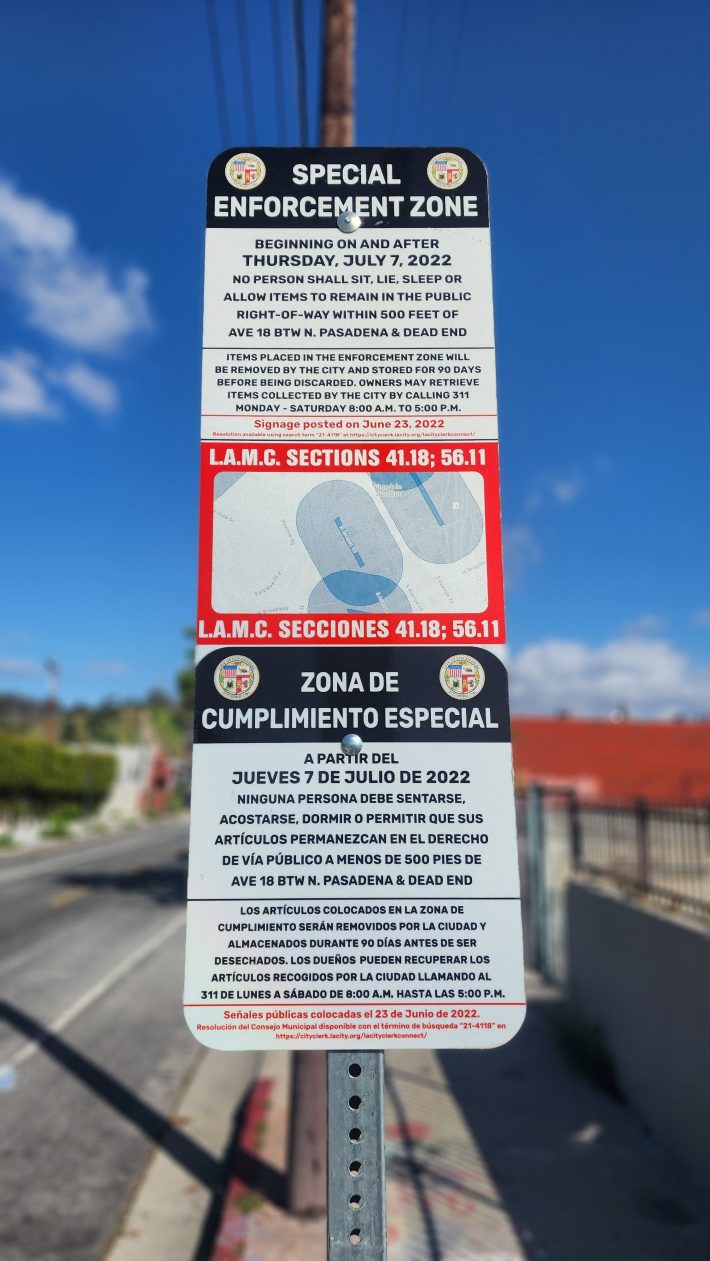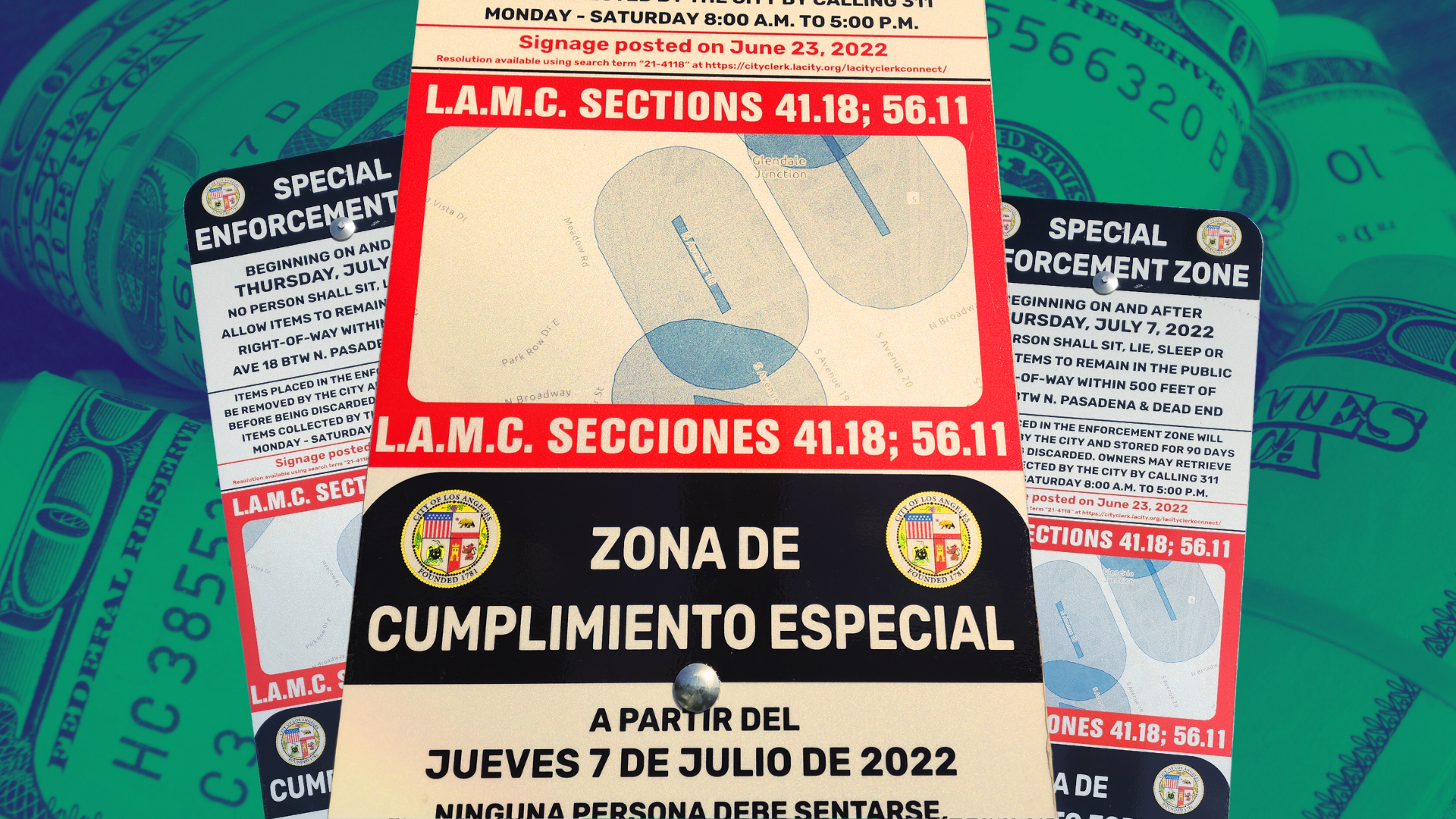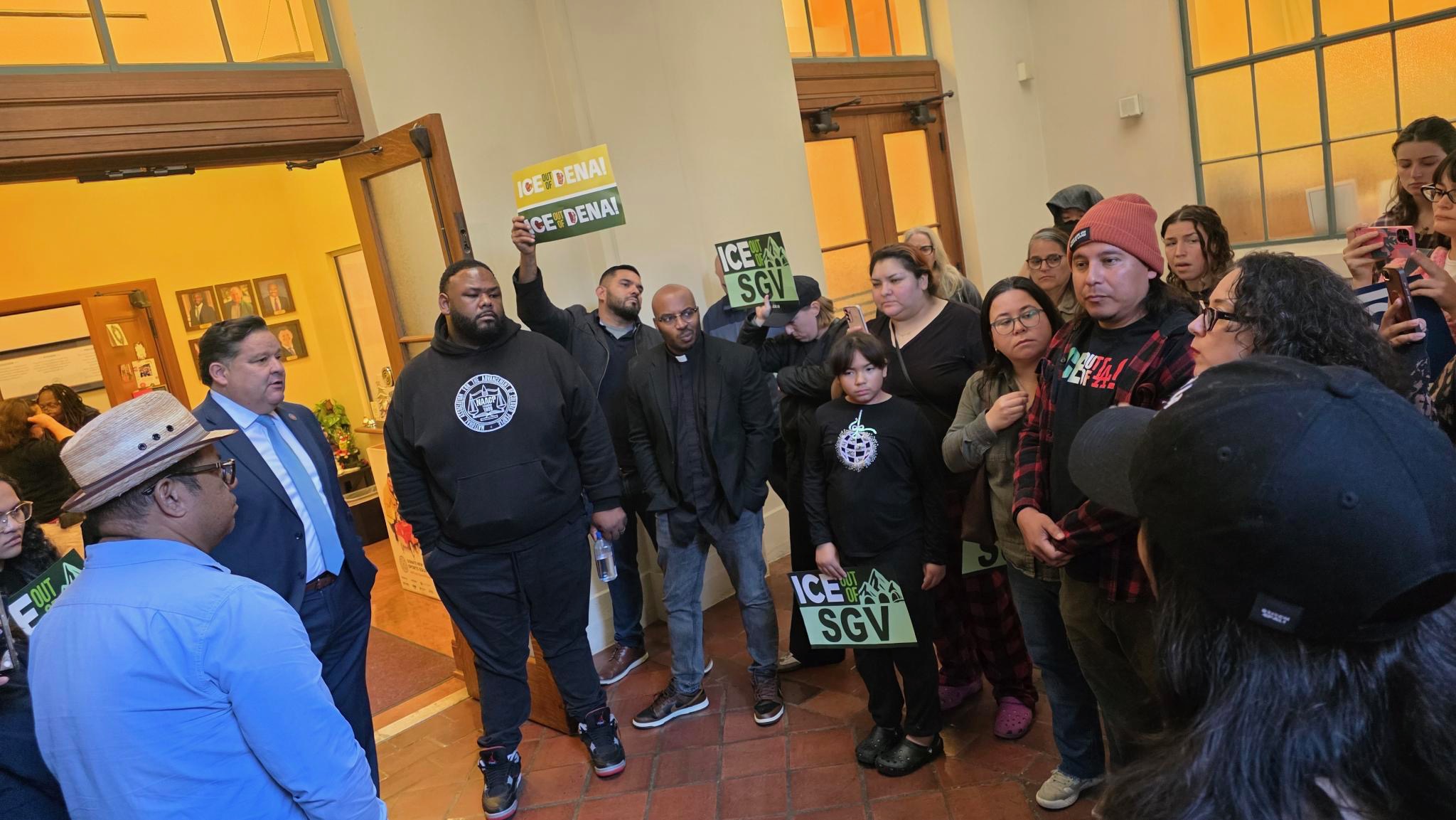The city of Los Angeles has spent more than $1.73 million on thousands of so-called “anti-homeless” signs in recent years, according to data from the City Administrative Officer (CAO) obtained by L.A. TACO.
The signs are part of the expansion of LAMC 41.18, the city’s controversial “anti-camping” law that bans homeless people from sitting, lying, or sleeping near schools and daycares.
Under the ordinance, the city council can also prohibit the unhoused from congregating in “sensitive areas,” such as active railways and rec centers, at the request of a council member.
The signs are made by the city’s General Services Division (GSD) and Iium Associates, a private strategic marketing and design firm.
Fabrication, installation, and maintenance make up the bulk of costs, according to a 2021 contract between Ilium and the city. But at the time, Ilium also anticipated spending tens of thousands of dollars on assessing locations, security as well as “camera ready art” and maps.

Signs made by Ilium cost the city $165 more per sign than signs made by GSD, according to the CAO’s data.
A spokesperson for the CAO's office confirmed that the CAO’s accounting of 41.18 signage costs covers the revised ordinance’s lifespan from mid-2021, when it was enacted, until this month.
The cost of 41.18 signage represents another piece of a larger puzzle.
Early last year, Councilmember Katy Young Yaroslavsky introduced a motion requesting that the city’s Chief Legislative Analyst (CLA) work in collaboration with several city departments on a report examining the efficacy of 41.18.
The motion requested that the report detail how much the city spent on “41.18 sign installation” and other expenses, including LAPD overtime hours.
That report is now more than eight months overdue.
Unhoused residents and advocates say that 41.18 zones “criminalize” homelessness, resulting in tickets, arrests, and people being pushed from one corner to another without offers of housing.
“It’s not surprising that the city, in prioritizing criminalization and banishment, spent millions on signs instead of actually trying to address the crisis of homelessness,” Los Angeles Community Action Network (LACAN) organizer, Adam Smith, said in response to our findings. “These 41.18 zones, like LAMC 41.18 generally, are a complete failure.”
A recent LACAN survey of 100 unhoused residents found that an overwhelming majority had their belongings taken by sanitation as a result of 41.18 enforcement, and nearly 40 percent said they weren’t offered any housing or shelter afterwards.
Some supporters of the “anti-camping” law say it’s helped clear large encampments and keep unhoused people from returning. Others complain that there isn’t enough enforcement and that cleared areas eventually become repopulated.

Earlier this month, a leaked memo from the Los Angeles Homeless Services Authority (LAHSA) similarly suggested that 41.18 rarely led to unhoused people being moved into interim shelter or permanent housing. After being cleared, most 41.18 zones quickly became repopulated.
LAHSA’s findings are one part of the overdue report on 41.18. The report will also include input from the city’s sanitation and police departments, the city attorney’s office, and the CAO.
Council President Paul Krekorian called the leaked memo from LAHSA possibly “deliberately misleading” while defending one of L.A.’s most controversial ways of dealing with encampments.
“The ordinance does not ‘criminalize homelessness,’ and it is not an alternative to housing programs like Inside Safe,” Krekorian said in a long-winded statement. “It simply prohibits encampments in specified limited areas that are especially dangerous to the unhoused themselves or that unreasonably impede the public’s use of the public right of way, or are adjacent to sensitive areas such as schools and child care centers.”
Paul Rubenstein, LAHSA’s Deputy Chief of External Relations, defended the agency’s findings in a statement to L.A. TACO and during a meeting of the board of commissioners this month. “LAHSA offered impartial analysis based on the available data,” Rubenstein said. “Our goal is always to provide honest assessments that will allow elected officials to make informed policy decisions.”
“Citations do not solve homelessness,” L.A. County Supervisor Lindsey Horvath said during the LAHSA commission meeting.
Although 41.18 is a city ordinance rather than a county law, Horvath believes it “pulls systemwide resources and applies pressure to a system that is already stretched past capacity.”
“These actions do not result in people becoming housed,” Horvath asserted. “Therefore, it is my opinion that 41.18 has been a waste of resources. We must prioritize our resources to the solutions we know to be most effective.”
“At Virgil Middle school in our district there was an encampment for years that would always come back after 41.18 was utilized,” Council District 13 spokesperson, Nick Barnes-Batista, told the commission. “But when we partnered with the mayor's office and two other council districts to actually offer housing during Inside Safe, we brought over 110 people inside and the area in front of the school has been clear without the need for 41.18 enforcement.”
“These sweeps just shuffle people from block to block and disconnect them from their services and case managers.”







